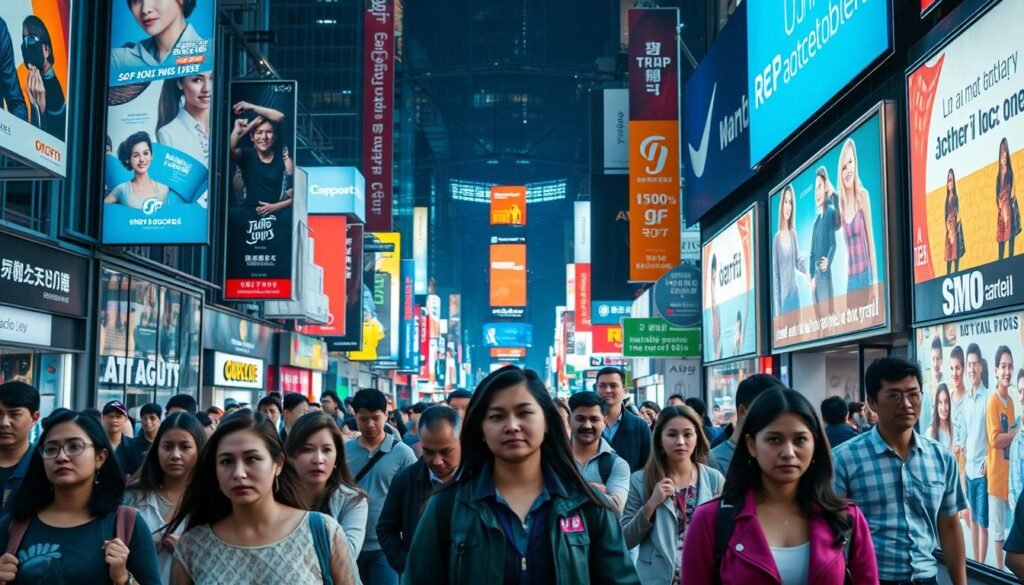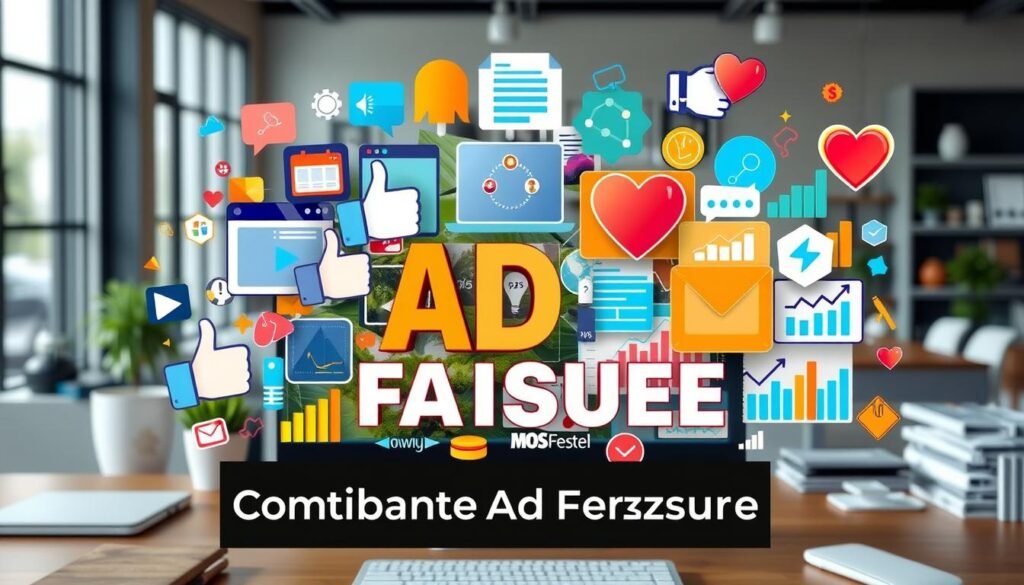Have you ever noticed how ads get ignored more the more they’re shown? It’s true that showing the same ad too much can lead to a big drop in how often people click on them. This problem is known as ad fatigue. It’s a big challenge for digital marketing that can really affect how well ads do. When people keep seeing the same ads, they start to tune them out.
This makes them less interested and can cause what we call ad burnout. It’s very important for marketers to understand ad fatigue. They need to keep their ads interesting in a world where people see lots of ads every day. We’re going to look into what causes ad fatigue. We’ll also talk about how to make your ads better and more engaging for your audience.
Key Takeaways
- A significant drop in click-through rates suggests potential ad fatigue.
- Monitoring engagement metrics is essential to identify and combat ad fatigue.
- Diversifying ad creatives can refresh audience interest and prevent burnout.
- Frequency capping can help reduce over-exposure and maintain effectiveness.
- Implementing dynamic ads allows for variations in content, keeping it fresh.
- Audience diversification can mitigate the effects of digital ad saturation.
Understanding Ad Fatigue
Ad fatigue is a big issue in today’s ad world. It happens when people see the same ads over and over. This leads to them paying less attention. Not just online ads, but traditional ones too are affected. To keep the audience interested, fresh ads are a must.
The Concept of Ad Fatigue
Knowing about ad fatigue is key for marketers. It means people get used to ads and stop noticing them. This results in fewer clicks and less interest in what’s being sold. If ads don’t change, people might start ignoring the brand.
Why It Matters for Marketers
Ad fatigue doesn’t just hurt sales now; it can also harm a brand’s image in the long run. Seeing the same ad too many times can annoy customers. This might make them less loyal. Marketers must watch their ads’ performance closely. This can show if ad fatigue is happening.
Using tools to check on ads automatically can save time. Trying new things, like changing ads regularly, can keep people interested. Adding stories with emotions to ads can also help. This keeps the audience engaged and connected to the brand.
What Is Ad Fatigue
Marketers need to understand ad fatigue to boost their ad impact. Ad fatigue means people engage less with ads they’ve seen many times. Today, with up to 10,000 ads bombarding us daily, it’s easy to feel overwhelmed.
Definition of Ad Fatigue
Ad fatigue happens when people get tired of seeing the same ads. This leads to lower click rates and less effective campaigns. Surveys show that 91% find ads intrusive, while 87% think there are more ads than ever. This results in ad overexposure, with folks starting to ignore ads completely.
How It Affects Audience Engagement
Seeing the same ads makes people less engaged. Signs include fewer social media interactions and campaign impressions. Marketers should update ad designs and use tools like ad customizers. This keeps ads interesting and relevant. Watching campaign stats, like ad frequency and click rates, helps spot ad fatigue early for quick changes.
With smart strategies, companies can overcome ad fatigue. Keeping ads fresh ensures messages stand out in a crowded digital space. Exploring decision fatigue might help marketers make better campaign decisions. This could improve campaign returns and keep audiences interested.
Signs of Ad Fatigue
It’s very important for marketers to know the signs of ad fatigue. This helps keep the audience interested and makes advertising efforts more effective. Looking at certain metrics that start to drop is a clear sign that your ads might be getting too repetitive. Spotting these signs early lets you make the right changes fast, stopping any further drop in performance.
Metrics to Watch For
Keeping an eye on certain metrics is key to spotting ad fatigue. Important measures to watch include:
- Click-through rates (CTRs): When CTRs go down, it means your audience isn’t as interested as before.
- Conversion rates: If fewer people are taking action, it’s costing you more to achieve less.
- Return on ad spend (ROAS): Falling ROAS shows that your ads aren’t hitting the mark as they used to.
- Impressions and reach: Less visibility means fewer new eyes on your ads, indicating rising fatigue.
- Cost per acquisition (CPA): Higher CPAs suggest that getting new customers is becoming more expensive due to ineffective ads.
Common Indicators of Declining Engagement
Ad fatigue leads to clear signs of less engagement. Here are some typical ones:
- Online engagement drops like fewer website visits or less foot traffic in stores.
- Brand connection weakens, shown by less brand recall and more consumer complaints.
- Too many ads are the same, making 67% of people want more variation in campaigns.
- Changing up your content can lead to a huge increase in how often people take action, by as much as 50%.
How Ad Fatigue Occurs
To understand ad fatigue, marketers must know two main things: frequency and repetitiveness. Seeing the same ads over and over again makes people less interested. So, controlling how often ads are shown is key.
Frequency and Repetitiveness
Ad fatigue occurs when ads appear too many times. This makes people care less about them. As a result, click-through rates and return on investment drop. Setting limits, like showing an ad once or twice a week, helps. It lets more people see the ad without annoying them.
Knowing when ads are shown too much is vital. It keeps people interested in your brand.
Impact of Digital Ad Saturation
Too many similar ads can hurt, too. When people see the same types of ads everywhere, they start to ignore them. This can make users sick of ads in general. Changing up ad styles and updating content can help. Watching how people interact with ads tells you if changes are needed.
Recognizing Ad Burnout
In the world of digital marketing, it’s key to spot ad burnout to keep campaigns working well. Ad burnout links to falling numbers in important metrics. It’s important to tell the difference between ad fatigue and too much ad showing. Ad fatigue happens when people get too used to seeing an ad, while too much ad showing hurts because of too much visibility.
Correlation with Ad Performance
It’s vital for marketers to watch out for signs of ad burnout. A drop in how often people click can show ad fatigue. It means the audience might be tired of seeing the same ads. A fall in conversion rates can show that people start to find the brand annoying. This bad feeling towards the brand can make people less engaged and cause missed chances to make sales.
Ad Fatigue vs. Ad Overexposure
Knowing the difference between ad fatigue and overexposure helps in making good marketing plans. Ad fatigue can make people less interested. On the other hand, overexposure can make costs go up without getting more sales. Seeing ads too often without wanting to engage is a big sign of ad burnout. Using strategies like A/B testing, dividing audiences, and making content personal can keep ads fresh and avoid both ad fatigue and overexposure.
The Role of Banner Blindness
Exploring the mind’s tricks in digital marketing leads to banner blindness. This is when people ignore banner ads, either on purpose or not. A shocking study from Infolinks in 2013 showed 86% of web surfers have banner blindness. This is a big problem for those trying to advertise.
What Is Banner Blindness?
Seeing too many banner ads makes people numb to them, causing banner blindness. These days, the success rate of these ads has dropped dramatically. From 1% success to just 0.05%. This drop is because there are too many ads, they’re placed where you expect, and they don’t fit the audience well. Millennials find this especially tiring, which lowers their interest even more.
How It Relates to Ad Fatigue
Ad fatigue is closely linked to banner blindness, and both are causing problems. Falling click rates mean less effective ads, like fewer people buying things or signing up. To fight this, marketers are getting creative. They’re making ads look more natural on the page or adding fun interactive parts.
A study looking at where people look on websites found a smarter way to show ads. This could be key as it’s harder than ever to get people’s attention. Only 0.8% of the time people spend on a site is looking where ads usually are. To get noticed, brands need new tactics and better targeting.

| Statistic | Value |
|---|---|
| Users displaying banner blindness | 86% |
| Average CTR decline | 1% to 0.05% |
| Attention to ads in right rail | 0.8% |
| Higher susceptibility group | Younger generations |
Impact of Ad Oversaturation
In today’s digital world, ad oversaturation is a big issue. Marketers try hard to grab our attention. But, they often go too far, bombarding us with too many ads. It’s crucial to know how this affects marketing efforts to create better advertising plans.
Understanding Digital Ad Saturation
Digital ad saturation means seeing too many ads every day. Studies show Americans see up to 10,000 ads daily. This constant flow can tire out or annoy people, causing them to ignore ads. Plus, 91% of people think ads are more intrusive now. Marketers must be careful to avoid making people feel overwhelmed by ads.
Consequences for Marketing Campaigns
Too many ads can hurt marketing efforts. With so many ads, people pay less attention, and it costs more to get new customers. Marketers also see fewer people taking action after seeing their ads too many times. A study from WordStream found that after seeing an ad six times, people are less likely to respond. Also, too much competition can lead to fake ad clicks, affecting nearly all Google Ads marketers in crowded markets.
To deal with too many ads, companies can use data to make smart decisions. Tools like predictive analytics help understand what customers like. This way, marketers can make ads that speak directly to people’s interests. Keeping an eye on how ads perform and changing tactics accordingly is key to staying effective.
Strategies to Combat Ad Fatigue
To fight ad fatigue, a mix of watching ad results and bringing in fresh ideas is key. Marketers need to watch ad performance closely to see when engagement drops and then adjust. They can use data to spot signs it’s time to change ads or use different creative works.
Monitoring Key Performance Indicators
Key performance indicators (KPIs) are vital for seeing if an ad is working well. Keeping an eye on things like click-through rates (CTR), cost-per-click (CPC), and how often an ad is shown helps understand if viewers are still interested. If an ad is shown too much, between 6-8 times, it could mean people are getting tired of it. Spotting a rise in CPC and a halt in campaign success are clues that it’s time to shake things up to keep the audience interested.
Creative Refresh and Rotation
A good strategy for changing ad creative can make viewers more interested again and lessen ad fatigue. Changing up ads regularly with new pictures or messages can make a big difference. It makes ads work better and clicks with consumers. Using content made by users is stronger by 35% compared to branded content. Partnering with influencers for genuine content also helps keep things fresh and draws in the audience.
| Ad Performance Metrics | Signs of Ad Fatigue |
|---|---|
| High Ad Frequency | Declining Click-Through Rates (CTR) |
| Increased Cost-Per-Click (CPC) | Stagnant Campaign Performance |
| Daily Exposure to 4,000 – 10,000 Ads | Poor Audience Feedback |

Rotating ad creative and updating strategies helps keep campaigns strong and keeps engagement steady. Using dynamic ads and personalized content makes viewers more interested and invites them to interact more. To learn more, check out strategies to avoid ad fatigue.
Diversifying Marketing Channels
Brands can boost their marketing by using different ad channels. By spreading out over many platforms, they can connect with various groups of people. This also lowers the chance of seeing ads too much. It keeps the brand message fresh in different places.
Benefits of Utilizing Multiple Platforms
Running ad campaigns across many channels has key benefits:
- Broader audience reach, allowing brands to connect with diverse demographics.
- Reduced chances of audience burnout due to repetitive messaging.
- Enhanced opportunities for testing different ad formats and creative approaches.
- Higher engagement through tailored content suitable for specific platforms.
Avoiding Digital Ad Saturation
Avoiding too many ads is vital in today’s market. Seeing the same content too often makes people less interested. It can make them tired of marketing. There are ways to lessen this problem:
- Implementing frequency caps to limit ad exposure.
- Regularly refreshing creative assets to keep the message vibrant.
- Utilizing tools like One-Click Report for analytics and performance tracking.
- Expanding target audiences and exploring new interests to avoid overexposure.
To prevent marketing fatigue, businesses need to use these strategies wisely. This makes advertising more lively and keeps audiences engaged.
The Importance of Creativity in Advertising
Creativity is key to keeping audiences interested. It helps avoid the downsides of ad fatigue. Presenting new content often is essential to improve ad performance. With people seeing up to 10,000 ads every day, standing out with innovative ideas is vital.
Enhancing Ad Performance Through Fresh Content
Creative advertising techniques boost user involvement. They also lower the chance of ad weariness. It’s good for marketers to change their ads every 4-6 weeks.
This keeps their material up-to-date and engaging. It fights against cost per click increases and click-through rate drops. Using engaging types like videos helps give users a novel experience that matches their interests.
Finding Balance Between Old and New Creatives
Finding the right mix of ad creatives means using what works and adding new ideas. For example, Intuit works with users to better their apps. This boosts engagement.
Companies like Walkers ask for customer ideas on new items. This builds stronger bonds and eases marketing efforts. Tracking campaign success with tools like NPS and CSAT helps refine creativity and guide ad strategies.

Continual Testing and Feedback Loops
It’s vital for marketers to implement continual testing and feedback loops. This approach helps improve ad performance and prevents ad fatigue. By closely monitoring, marketers can refine their strategies. They use insights from how audiences react to different ads.
Implementing a Creative Feedback Loop
A robust creative feedback loop encourages innovation. It involves regularly collecting feedback from consumers and analyzing data. By doing so, advertisers can quickly change their approach. This is crucial for addressing inconsistencies in audience engagement found in ad testing. It helps avoid banner blindness, where most consumers ignore repeated banner ads.
The Role of A/B Testing
A/B testing is a key method to better understand creative impact. It lets marketers compare ad versions to decide which works best. This approach helps pinpoint audience preferences, enhancing campaign results. With ongoing A/B testing, marketers see better conversion rates and lower CPAs as they adjust to consumer likes.
| Testing Method | Benefits | Challenges |
|---|---|---|
| A/B Testing | Data-driven insights on creative effectiveness | Requires significant time and resources for testing |
| Creative Feedback Loop | Continuous improvement based on audience response | Risk of overwhelming feedback complexity |
| Real-time Performance Analysis | Quick adjustments to improve ad effectiveness | Analytics can sometimes misinterpret consumer behavior |
Using these strategies is crucial for keeping audiences engaged. As ads need constant updates, ongoing testing and refinement are key. This ensures success in a tough market.
Conclusion
Marketers need to know how to manage ad fatigue to keep their campaigns strong and keep people interested. Every day, people see lots of ads. This means brands must spot when ads stop working well. This happens when ads are seen too much and don’t get clicks anymore.
To keep ads fresh and engaging, brands should change them regularly. This helps avoid viewer burnout. Making sure ads are interesting and relevant is key. This keeps the message strong and gets people’s attention.
To really stand out, marketers need to be creative and know what their audience likes. Using detailed targeting helps make ads feel more personal. This is important for getting people to pay more attention to ads.
Dealing with problems like seeing the same ad too much is crucial. Companies can keep a strong bond with their audience this way. This also helps use resources wisely.
Managing ad fatigue means always testing and updating ads. Understanding what users like and don’t like is also important. This approach helps keep advertising lively. It draws attention and keeps it.
In the end, being proactive against ad fatigue helps marketers succeed. It leads to better interactions with customers and more loyalty to the brand.